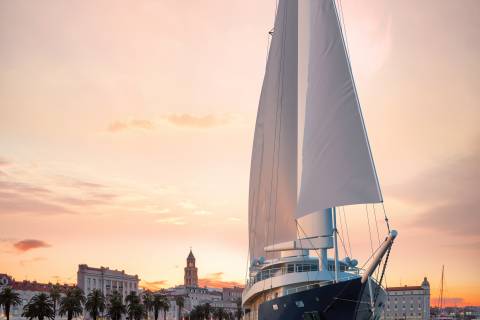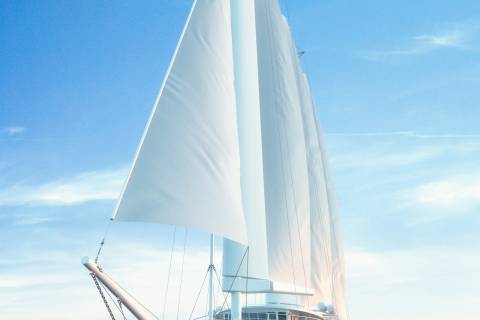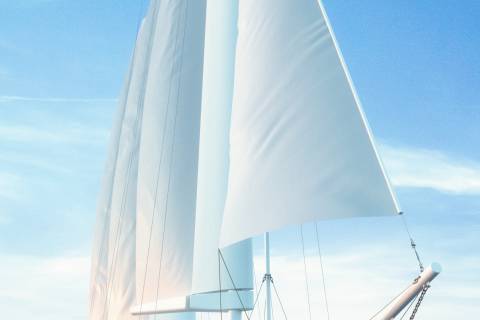A zero-emission passenger sailing ship, powered by electric motors, is under construction.
The design and complete project-classification documentation were created by designers from the company Marine and Energy Solutions DIV d.o.o., a project partner that, through this endeavor, confirms its key role in positioning the DIV group high on the list of technical competencies and construction competitiveness.
Main particulars
- Overall length ……………………………………………………. 63.50 m
- Breadth ………………………………………………………......... 10 m
- Tonnage ………………………………………………………... < 500 GT
- Propulsion electric motors ……………………………………. 2x150 kW
- Cruising speed/Power………………………………………….. 6 knots/73 kW
- Power supply……………………………………………………….. batteries
- Battery capacity…………………………………………………… max. 2600 kWh
- Electric generator......................................................................... 2 x 112 kW
- Sails .................................................................................................. 3 x 165 m2
- Crew ................................................................................................ 10 members
- Passenger capacity………………………………………………...... 36 passengers
This electric sailing ship, a three-masted schooner, will be 63.50 meters long, 10 meters wide, and 5.35 meters high up to the main deck. The hull and superstructure are made of steel, while the masts will be constructed from an aluminum alloy. When not using its sails, the ship will be propelled by two electric motors, each with a power of 150 kW, powered by a battery system that is continuously charged from various sources. At a speed of 6 knots, approximately 73 kilowatts of power will be required, which is remarkably efficient for a 500 GT vessel. The ship will be equipped with 15 tons of batteries with a maximum capacity of 2600 kWh. Due to regulatory requirements, there will also be two diesel generators that will only be used in cases of need or emergency.
With the help of two electric motors, each with a power of 150 kW, powered by a battery system charged from various renewable energy sources, the ship will sail quietly and without vibrations, most often in “Sailing mode,” or will be powered by electricity from the battery source. The photovoltaic solar power plant on the superstructure roof will contribute to the sailboat’s energy independence by heating water. Additionally, the ship’s fixed-blade propeller system with special blade geometry will act as a hydroturbine during sailing, thus charging the batteries as well.
Solar panels on the superstructure roof will be used for heating water. This will ensure that the ship is supplied with electricity and water from fully renewable sources, with zero CO2 emissions. This means that, aside from being 100% ‘green,’ the ship will practically have no fuel or propulsion system costs. What sets this electric sailboat apart from similar vessels is its ability to recharge its batteries while sailing, using a very ingenious approach. In addition to solar panels, it will utilize a propeller system with specially designed blades to function as primary hydroturbines while under sail. This reversible energy flow (“reversible propeller”) will allow for charging the large-capacity batteries in the hold.
Furthermore, all onboard information will be monitored from the command bridge. This includes meteorological data, which will help the captain find the most favorable wind conditions, as well as the status of all ship and propulsion systems, battery power reserves, motor functioning, solar panels, wind turbines, hot water, energy consumption, and more. This will enable complete control over all “income” and “expenditure” of energy onboard.
The sailboat will have the classification of passenger ships for unrestricted navigation and will be capable of sailing in all the world’s seas. The project commenced in February 2020 and has been co-financed with funds from the EU through the call ‘Increasing the development of new products and services resulting from research and development (IRI) – phase II.’
The goal of the project is the research, development, and construction of an eco-innovative passenger sailboat for cruises, accommodating at least 36 passengers. Alternative propulsion technologies and energy sources based on eco-friendly design have been developed, focusing on sustainable mobility with zero emissions of exhaust gases, supporting environmental sustainability, and reducing greenhouse gas emissions, air pollution, and noise.
The project leader is DIV group, and collaboration has been established with scientific institutions to enhance the interaction and transfer of knowledge and technology between industry and higher education and research institutions, benefiting both companies and researchers from the public sector.
The Faculty of Electrical Engineering, Computer Science, and Information Technology Osijek (FERIT) is responsible for developing the wind kinetic energy storage system through hydrokinetic energy conversion (hydroturbines and reversible propellers) and the battery management system/integrated energy system of the ship (energy storage, monitoring, and management). The Faculty of Electrical Engineering, Mechanical Engineering, and Naval Architecture in Split (FESB) is working on the rigging system, automation of rigging (robotization), and solar panels.





